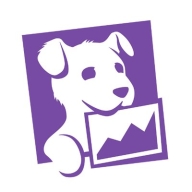

Datadog and Google Cloud's operations suite compete in the cloud application performance monitoring sector. Datadog tends to have the upper hand due to its intuitive user experience and comprehensive integrations, whereas Google Cloud caters to those deeply embedded in GCP.
Features: Datadog features strong integration with AWS, intuitive tagging, and robust dashboards that simplify complex monitoring. Its setup is seamless, supporting diverse integrations for straightforward infrastructure management. Google Cloud's operations suite offers strong logging and tracing capabilities, particularly beneficial for GCP users, and provides insights into uptime and performance.
Room for Improvement: Datadog could enhance data handling by improving older data retrieval speed and refining dashboard sharing. Its pricing model needs more transparency to control unexpected costs, and it could expand real-time tracking features. On the other hand, Google Cloud's operations suite could enhance its APM functionalities and improve insights into request-level performance breakdowns, as well as strengthen error traceability compared to specialized APM tools.
Ease of Deployment and Customer Service: Datadog supports public, private, and hybrid clouds, offering more deployment flexibility than Google Cloud, which focuses on Google infrastructure. Datadog is praised for its proactive customer service, although support quality can vary. Google Cloud benefits from integration with Google Cloud Platform services but requires more comprehensive technical support.
Pricing and ROI: Datadog’s pricing may seem high, particularly during utilization spikes, yet its robust functionality often justifies the cost despite a complex pricing structure. Google Cloud's operations suite is seen as more budget-friendly, especially for those heavily invested in GCP, though its ROI is optimal when adapted to Google's environment, lacking Datadog’s broader application scope.
| Product | Market Share (%) |
|---|---|
| Datadog | 6.6% |
| Google Cloud's operations suite (formerly Stackdriver) | 1.1% |
| Other | 92.3% |


| Company Size | Count |
|---|---|
| Small Business | 80 |
| Midsize Enterprise | 46 |
| Large Enterprise | 95 |
| Company Size | Count |
|---|---|
| Small Business | 2 |
| Midsize Enterprise | 1 |
| Large Enterprise | 8 |
Datadog integrates extensive monitoring solutions with features like customizable dashboards and real-time alerting, supporting efficient system management. Its seamless integration capabilities with tools like AWS and Slack make it a critical part of cloud infrastructure monitoring.
Datadog offers centralized logging and monitoring, making troubleshooting fast and efficient. It facilitates performance tracking in cloud environments such as AWS and Azure, utilizing tools like EC2 and APM for service management. Custom metrics and alerts improve the ability to respond to issues swiftly, while real-time tools enhance system responsiveness. However, users express the need for improved query performance, a more intuitive UI, and increased integration capabilities. Concerns about the pricing model's complexity have led to calls for greater transparency and control, and additional advanced customization options are sought. Datadog's implementation requires attention to these aspects, with enhanced documentation and onboarding recommended to reduce the learning curve.
What are Datadog's Key Features?In industries like finance and technology, Datadog is implemented for its monitoring capabilities across cloud architectures. Its ability to aggregate logs and provide a unified view enhances reliability in environments demanding high performance. By leveraging real-time insights and integration with platforms like AWS and Azure, organizations in these sectors efficiently manage their cloud infrastructures, ensuring optimal performance and proactive issue resolution.
Real-time log management and analysis
Cloud Logging is a fully managed service that performs at scale and can ingest application and platform log data, as well as custom log data from GKE environments, VMs, and other services inside and outside of Google Cloud. Get advanced performance, troubleshooting, security, and business insights with Log Analytics, integrating the power of BigQuery into Cloud Logging.
Built-in metrics observability at scale
Cloud Monitoring provides visibility into the performance, uptime, and overall health of cloud-powered applications. Collect metrics, events, and metadata from Google Cloud services, hosted uptime probes, application instrumentation, and a variety of common application components. Visualize this data on charts and dashboards and create alerts so you are notified when metrics are outside of expected ranges.
Stand-alone managed service for running and scaling Prometheus
Managed Service for Prometheus is a fully managed Prometheus-compatible monitoring solution, built on top of the same globally scalable data store as Cloud Monitoring. Keep your existing visualization, analysis, and alerting services, as this data can be queried with PromQL or Cloud Monitoring.
Monitor and improve your application's performance
Application Performance Management (APM) combines the monitoring and troubleshooting capabilities of Cloud Logging and Cloud Monitoring with Cloud Trace and Cloud Profiler to help you reduce latency and cost so you can run more efficient applications.
We monitor all Application Performance Monitoring (APM) and Observability reviews to prevent fraudulent reviews and keep review quality high. We do not post reviews by company employees or direct competitors. We validate each review for authenticity via cross-reference with LinkedIn, and personal follow-up with the reviewer when necessary.